Image Transfer to FTP Servers
- Preparation
- Connecting to the Access Point
- Configuring FTP Server Connection Settings
- FTP Transfer Settings
- Transferring Multiple Images at Once
- Adding a Caption Before Transfer
- Auto Retry If Transfer Fails
- Viewing Transferred Images
Your images can be transferred to an FTP server on the network the camera is connected to.
Note
- JPEG/HEIF images can be resized or cropped during the transfer process.
Preparation
A computer running one of the following OSes is required. The computer must also be set up in advance to function as an FTP server.
- Windows 10 (ver. 1607 or later)
- Windows 8.1, Windows 8.1 Pro
For instructions on setting up the computer to function as an FTP server, refer to documentation for your computer.
Connect the computer to use as an FTP server to the access point in advance.
Connecting to the Access Point
-
Set Wi-Fi settings to [Enable].
- See steps 1–2 in Connecting to a Bluetooth-Compatible Smartphone via Wi-Fi.
-
Select [
: Wi-Fi/Bluetooth connection].
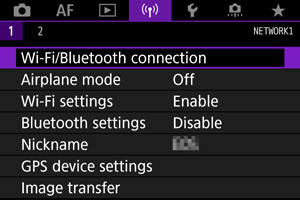
-
Select [
Transfer images to FTP server].
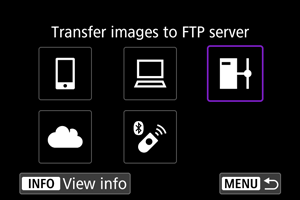
-
Select [Add a device to connect to].
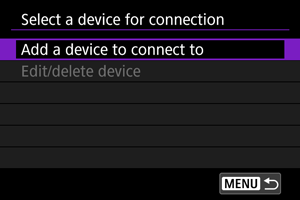
-
Select [Setting method].

- Select an option and then [OK] to go to the next screen.
- Select [Configure online] to configure connection settings and then join the network.
- Select [Configure offline] to configure FTP server connection settings without connecting.
-
Select [Connect with WPS].
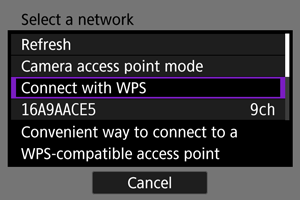
- Follow these steps to connect via WPS (PBC mode). To connect to access points in other ways, see Wi-Fi Connection via Access Points.
-
Select [WPS (PBC mode)].

- Select [OK].
-
Press the WPS button on the access point.

- For details on where the WPS button is and how long to press it, refer to the access point user manual.
- Select [OK] to initiate connection with the access point. The following screen is displayed once the camera is connected to the access point.
-
Select an IP address setting option.
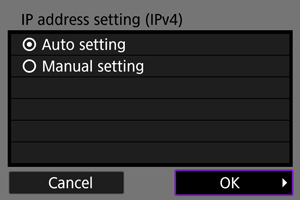
- Select [OK].
-
Select an IPv6 option.

- Select [OK].
Configuring FTP Server Connection Settings
-
Select an FTP mode.

- For secure FTP transfer using a root certificate, select [FTPS]. For details on root certificate settings, see Set Root Certif.
- Select [OK] to go to the next screen.
-
Select [Address setting].

- Select [OK] to go to the next screen.
- The virtual keyboard is displayed if you have specified [Auto setting] for the IP address or [Manual setting] for the DNS address.
- A screen for numerical input is displayed if you have specified [Disable] for the DNS address.
-
Enter the FTP server IP address.

-
Configure the port number.
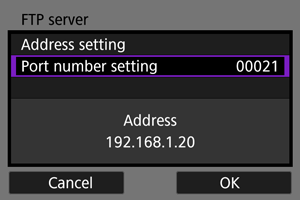
- Normally, set [Port number setting] to 00021.
- Select [OK] to go to the next screen.
-
Configure the passive mode setting.
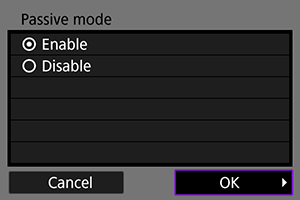
- Select [OK] to go to the next screen.
- If an Error 41 (Cannot connect to FTP server) is displayed in step 8, setting [Passive mode] to [Enable] may resolve it.
-
Configure proxy server settings.
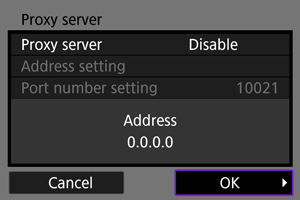
- Not displayed if you selected [FTPS] in step 1.
- Select [OK] to go to the next screen.
-
Configure the login method.
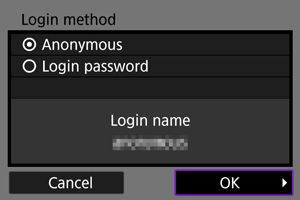
- Select [OK] to go to the next screen.
-
Specify a target folder.
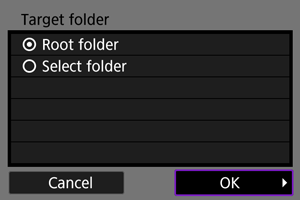
- Select [Root folder] to have images saved in the root folder, as specified in FTP server settings.
- Select [Select folder] to specify a target folder in the root folder. If the folder does not exist, it is created automatically.
- Select [OK] to go to the next screen.
- When the following message appears, select [OK] to trust the target server.
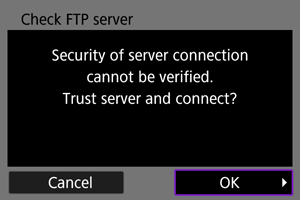
-
Select [OK].

- Not displayed in offline configuration.
Connection settings for FTP transfer are now complete.
FTP Transfer Settings
You can configure settings related to FTP transfer and power saving.
-
Select [
: Wi-Fi settings].

-
Select [FTP transfer settings].
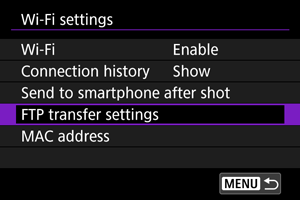
-
Select an option to configure.
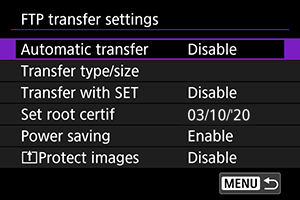
-
Automatic transfer
Select [Enable] for automatic image transfer to the FTP server immediately after shooting. You can continue shooting still photos as usual while images are being transferred.
Caution
- Before shooting, make sure a card is in the camera. If you shoot without recording images, they cannot be transferred.
- Automatic transfer of movies during recording is not supported. After recording, transfer movies as described in Transferring Multiple Images at Once or Adding a Caption Before Transfer.
- Images cannot be erased during image transfer.
Note
- During continuous shooting, images are transferred to the FTP server in the order they are captured.
- Captured images are also stored on the card.
- In the case of any images for which transfer fails or is interrupted, the camera attempts transfer again automatically when the connection is recovered (). You can also try again later to manually transfer all of these images at once ().
- Any changes to network settings (such as FTP server settings) before automatic FTP transfer begins will prevent automatic transfer.
-
Transfer type/size
In [JPEG size to trans.], you can specify the size of images to transfer. For example, to transfer smaller JPEGs when the camera is set to record larger JPEGs to one card and smaller JPEGs to the other, set to [SmallerJPEG].
In [RAW+JPEG transfer] or [RAW+HEIF transfer], you can specify the type of images to transfer.
Note
- When the camera is set to record RAW images to one card and JPEGs or HEIFs to the other, specify which images to transfer in the [RAW+JPEG transfer] or [RAW+HEIF transfer] setting. Similarly, specify your transfer preference when RAW+JPEG images or RAW+HEIF images are simultaneously recorded to a single card.
- Captured images are also stored on the card.
- When images of the same size are recorded to both cards simultaneously, images recorded to the card selected for [
Record/play] or [
Play] in [
: Record func+card/folder sel.] are given priority for transfer.
-
Transfer with SET
When set to [Enable], simply press
to transfer the image displayed. You can continue shooting still photos as usual while images are being transferred.
Note
- Movies cannot be transferred this way.
-
Set root certif
If you specified [FTPS] FTP mode when configuring connection settings, the root certificate used by the FTPS server must be imported to the camera.
Caution
- Only the root certificate with a file name of “ROOT.CER,” “ROOT.CRT,” or “ROOT.PEM” can be imported to the camera.
- Only one root certificate file can be imported to the camera. Insert a card containing the root certificate file in advance.
- The priority card selected for [
Record/play] or [
Play] in [
: Record func+card/folder sel.] is used to import a certificate.
- It may not be possible to trust servers you try to connect to in FTPS connections with a self-signed certificate.
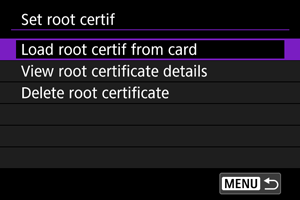
Select [Load root certif from card] to import the root certificate on the card.
To check who the root certificate was issued to and issued by, and the period of validity, select [View root certificate details].
To delete the root certificate imported to the camera, select [Delete root certificate].
-
Power saving
When [Enable] is set and no image is transferred for a certain period, the camera will log off from the FTP server and end the Wi-Fi connection. The connection is re-established automatically when the camera is ready for image transfer again. If you prefer not to end the Wi-Fi connection, set to [Disable].
-
Protect images
To automatically protect images transferred via FTP, set to [Enable]. ()
-
Transferring Multiple Images at Once
After shooting, you can select multiple images and transfer them all at once, or you can transfer unsent images or images that could not be sent previously.
You can continue shooting still photos as usual during transfer.
Caution
- Image transfer in progress is paused if you switch to movie mode. To resume image transfer, switch to photo mode.
Selecting images to transfer
-
Select [
: Image transfer].
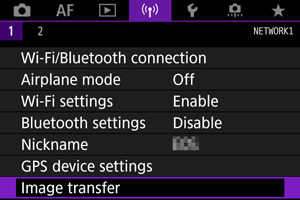
-
Select [Image sel./transfer].

-
Select [FTP transfer].
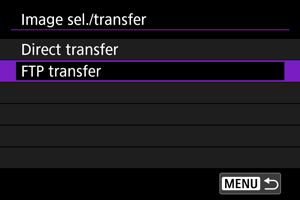
-
Select [Sel.Image].
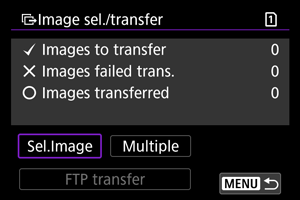
-
Select the image to transfer.

- Use the
dial to select an image to transfer, then press
.
- Use the
dial to add a checkmark [
] in the upper left of the screen, then press
.
- You can turn the
dial counterclockwise to switch to select the images from 3-image display. To return to single-image display, turn the
dial clockwise.
- To select other images to transfer, repeat step 5.
- After image selection, press the
button.
- Use the
-
Select [FTP transfer].
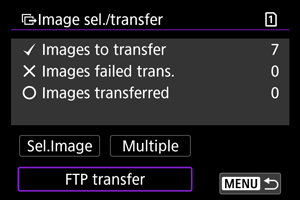
-
Select [OK].

- The selected images are transferred to the FTP server.
Selecting multiple images
Multiple images can be transferred at once after you choose a selection method. You can continue shooting still photos as usual while images are being transferred.
-
Access the [Image sel./transfer] screen.
- Follow steps 1–3 in Selecting Images to Transfer.
-
Select [Multiple].

-
Select a selection method to use.
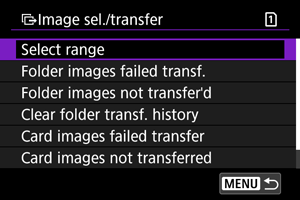
-
Select range

- Select [Select range]. Selecting the first and last images of the range marks all the images in the range with a checkmark [
], and one copy of each image will be sent.
- To change the number of images in index display, turn the
dial.
- Select [Select range]. Selecting the first and last images of the range marks all the images in the range with a checkmark [
-
In a folder
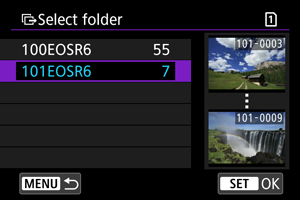
- Selecting [Folder images failed transf.] selects all images in the selected folder for which transfer failed.
- Selecting [Folder images not transfer'd] selects all unsent images in the selected folder.
- Selecting [Clear folder transf. history] clears the transfer history of images in the selected folder. After clearing the transfer history, you can select [Folder images not transfer'd] and transfer all images in the folder again.
-
In a card

- Selecting [Card images failed transfer] selects all images in the selected card for which transfer failed.
- Selecting [Card images not transferred] selects all unsent images in the selected card.
- Selecting [Clear card's transf. history] clears the transfer history of images in the selected card. After clearing the transfer history, you can select [Card images not transferred] and transfer all images in the card again.
-
-
Select [FTP transfer].
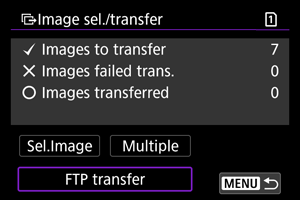
-
Select [OK].

- The selected images are transferred to the FTP server.
Transferring RAW+JPEG or RAW+HEIF images
For RAW+JPEG or RAW+HEIF images, you can specify which image to transfer.
-
Select [
: Image transfer].
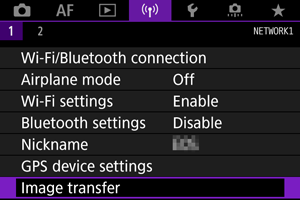
-
Select the type of images to transfer.
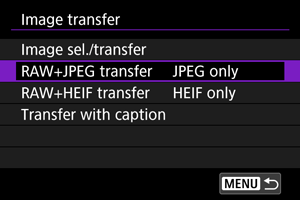
-
RAW+JPEG transfer
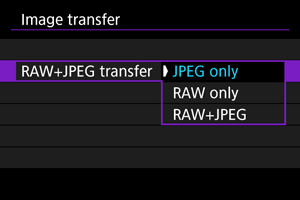
- Select [RAW+JPEG transfer], then select [JPEG only], [RAW only], or [RAW+JPEG].
-
RAW+HEIF transfer
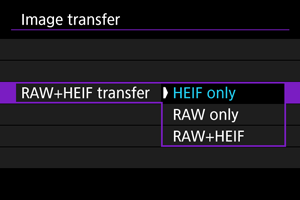
- Select [RAW+HEIF transfer], then select [HEIF only], [RAW only], or [RAW+HEIF].
-
Caution
- Some menu items are not available during image transfer.
Adding a Caption Before Transfer
You can add a registered caption to each image before transfer. This is convenient if you want to inform the recipient of the printing quantity, for example. Captions are also added to images saved to the camera.
- You can check captions added to images by examining the Exif information, in the user comments.
- Captions can be created and registered with EOS Utility ().
-
Select [
: Image transfer].
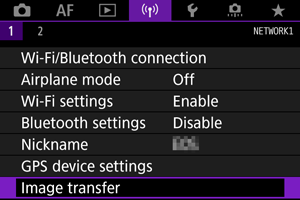
-
Select [Transfer with caption].
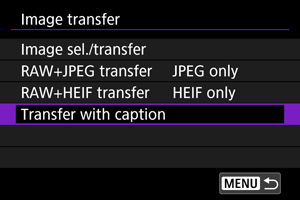
- The last image viewed is displayed.
-
Specify the caption.
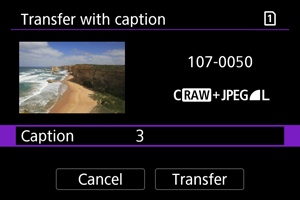
-
Select [Caption], and on the screen displayed, select the content of the caption.
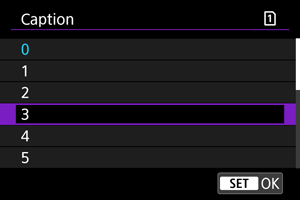
-
-
Select [Transfer].
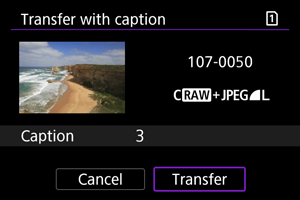
- The image is transferred with the caption. After transfer, display returns to the [Image transfer] screen.
Caution
- Other images cannot be selected from the [Transfer with caption] screen. To select another image for transfer with a caption, view that image before following these steps.
Auto Retry If Transfer Fails
If transfer fails, the camera's access lamp blinks in red. In this case, the following screen is displayed after you press the button and select [
: Wi-Fi/Bluetooth connection].
To resolve the error displayed, see the troubleshooting information ().
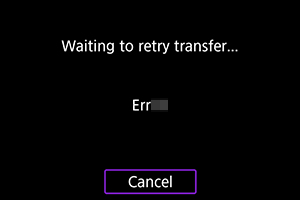
Once you have resolved the issue, the images that could not be sent initially will be transferred automatically. With this option activated, transfer is attempted again automatically after failure, whether automatic transfer is used or captured images are transferred manually via FTP. Note that if you cancel transfer or turn the camera off, auto retry is not attempted.
See Transferring Multiple Images at Once and transfer images as needed.
Viewing Transferred Images
Images transferred to the FTP server are stored in the following folder as specified in the FTP server settings.
-
Target folder of the FTP server
- Under the default settings of the FTP server, images are stored in [C drive] → [Inetpub] folder → [ftproot] folder, or in a subfolder of this folder.
- If the root folder of the transfer destination has been changed in the FTP server settings, ask the FTP server administrator where images are transferred.